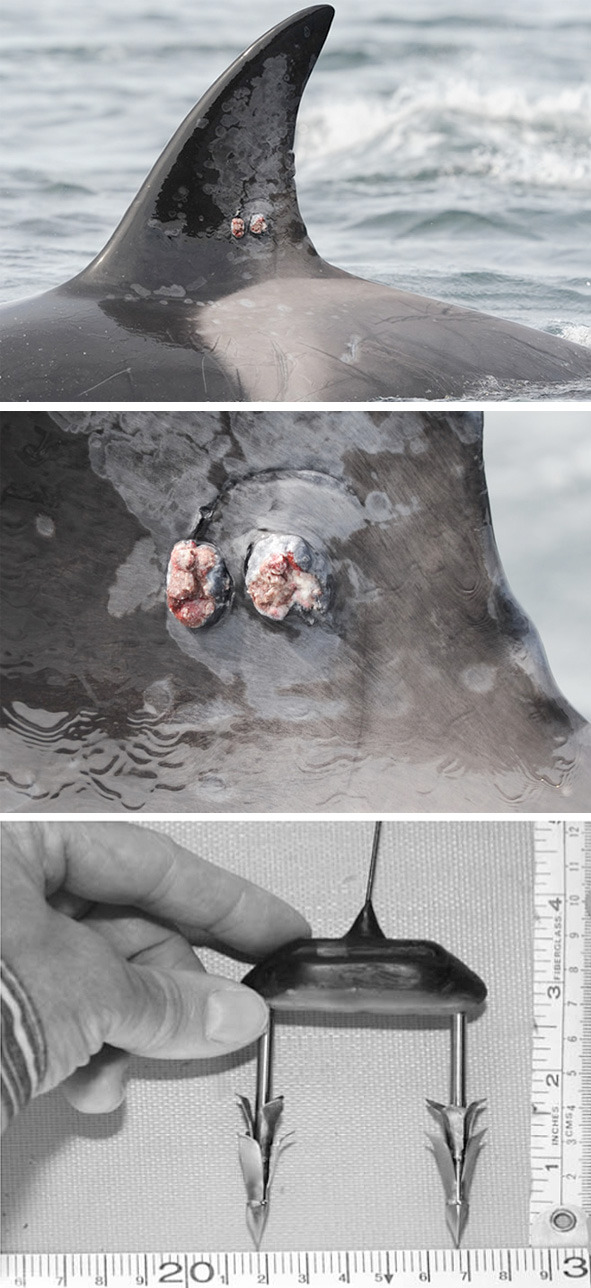|
|
Banning Barbaric Satellite "tags"
posted on October 6, 2016

Lifeforce Position Re: Banning Barbaric Satellite "Tags" (Updated October 6)
Endangered orcas are being studied to death!
The death of orca L95 in March 2016 led the US responsible parties to halt all barbaric satellite "tags" pending a review. The "tags" are actually sharp barb-like blades that penetrate the skin. On October 4th a press conference was held by NOAA Fisheries. At that meeting the following information was given:
1. The death of L95 was due to a fungal infection. The first dart attempt failed and due to human error it was not properly sterilized as per protocol. It was also done in waters that was known to have this fungus.The dart was shot into the area of the dorsal fin where large blood vessel are located.
2. Unlike Canada that is not using satellite tags since it is deemed too invasive and alternatives are available, NOAA will only suspend the experiments on the endangered SRKWs pending a review. This will not include Transient orcas who also had been tagged and two went missing afterwards. (Alternatives include suction cup tags and underwater sound buoys)
3. L95 had parts of the dart remain in the body and other cases have been reported over the years. The issue of pain was not discussed. It was stated that one of the ways the tags are removed is by being bitten off by other orcas.
Right whales had swelling from infections and “dolphins” died during “handling” to attach tags.
4. It was stated that it is always a "risk" and NOAA will look at reducing the risks. They said that the researchers were "dismayed" at the possibility that they killed an endangered orca.
BACKGROUND
Four days after the tagging penetration the researchers did see L95 and others with visible ribs. This was a sign of at least nutritional stress or illness. They should not have caused further stress and put L95 at any risk by shooting him with a painful tracking tag. Also, US authorities agree that satellite tag penetration can cause pathways for infection from viruses and bacteria. That threat alone should have stopped it years ago.
Why did it only come to light at that time that two other orcas died shortly after being satellite tagged and seven orcas have metal pieces from the tags still embedded into their sensitive, vulnerable bodies? A suspension and review should have been conducted immediately after the first death of a transient orca. Perhaps then the tragic death of this endangered Southern Resident would have been prevented.
There must also be a review of harmful skin biopsy experiments. Researchers conduct extremely close pursuits on the orcas’ backs then shoot a biopsy dart into them. It has been observed that the orcas have shaken with fear (dorsal fins quivered). In one case the two offspring of their darted mother shook with fear.
In the 90s, Lifeforce raised the issue of shooting orcas with biopsy darts in the San Juan Islands. After public opposition, that proposed studied did not move forward but later researchers, who are also using satellite tags, also used biopsy darts.
These skin biopsies would also cause pathways for toxic pollution, bacteria, and viruses to infect orcas. An investigation should have included any deaths of those orcas who were biopsied too.
Hopefully a thorough review of cumulative research impacts will put an end to at least the inhumane satellite tagging and skin biopsies. In addition to food depletion and pollution, the the negative impacts from boat traffic is recognized as one of the three major threats. It should include whale watch companies, private boaters, and research boats. There must be a joint US and Canada review committee to look at the cumulative impact of all the experiments on transboundary SRKWs and other threatened species facing extinction. There must be a public information and comment period.
Sentient orca families must not continue to be treated as research tools for lucrative research grants. Science for the sake of scientists must not put endangered species at risk. As Lifeforce has repeatedly stated, “They are being studied to death and it must be stopped immediately!”
More information at Ocean Friends: https://www.facebook.com/Ocean-Friends-1442963759271400/
|
| |
| |
|
|